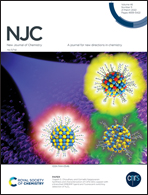Design and thermophysical characterization of betaine hydrochloride-based deep eutectic solvents as a new platform for CO2 capture†
Abstract
Deep eutectic solvents (DESs) are emerging as a new generation of sustainable and green media. Concerning the same, the present work outlines the synergistic information provided from the thermophysical assessment on new betaine hydrochloride (BHC)-based DESs. In order to acquire stable and convenient DESs, BHC as a hydrogen bond acceptor (HBA) is combined with urea (U) as a primary hydrogen bond donor (HBD) and ethylene glycol (EG), diethylene glycol (DEG), triethylene glycol (TEG), and glycerol (GLY) as secondary HBDs. A series of four different DESs, namely DES1 (BHC : U : EG), DES2 (BHC : U : DEG), DES3 (BHC : U : TEG), and DES4 (BHC : U : GLY) were optimized by a capricious molar ratio (1 : 4 : 2.5), which offers satisfactory liquid stability. Comprehensive spectral studies were used to investigate the molecular structure and the hydrogen bonding of the prepared DESs, while the important thermophysical properties viz., thermal stability (Tdec), density (ρ), speed of sound (u), viscosity (η), electric conductivity (κ), and refractive index (nD) were investigated at different temperatures. The effect of temperature on the measured thermophysical findings was correlated using a thermodynamic model. The viscoelastic and rheological findings revealed a considerable shift in the flow regime with varying HBDs in the prepared DESs. Furthermore, from an application viewpoint, these task-specific DESs were used for CO2 capture, where the outcomes indicated that DES2 (BHC : U : DEG) showed a high uptake of CO2 at 0.0200 mol of CO2/mol DES, which increased to 0.0319 mol of CO2/mol DES in DES2 in the presence of superbase (1,5-diazabicyclo[4.3.0]-non-5-ene (DBN)). Spectral studies indicated that CO2 reacts with the -NH2/-OH centers of DES via R–O–C![[double bond, length as m-dash]](https://www.rsc.org/images/entities/char_e001.gif) OO−/–R–NH–C
OO−/–R–NH–C![[double bond, length as m-dash]](https://www.rsc.org/images/entities/char_e001.gif) OO− formation during CO2 capture. Overall, the prepared DESs exhibit long-term performance in CO2 capture, which qualifies them as prospective and suitable alternatives to ILs.
OO− formation during CO2 capture. Overall, the prepared DESs exhibit long-term performance in CO2 capture, which qualifies them as prospective and suitable alternatives to ILs.



 Please wait while we load your content...
Please wait while we load your content...